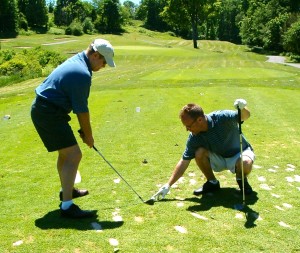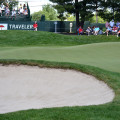
Swing advice and a nervous breakdown can go hand-in-hand. Have you ever tried reading all the advice on how to play better golf? “The Easy Way to Perfect Impact!” “Stop Slicing Now!!” “Never Miss a Shot!!!” These are actual headlines taken from three editions of Golf Magazine (April, May and June, 2010).
In April, I’m thoroughly confused: There’s photos of the pro at impact, with numbers at his shoulder, chest, grip and clubface – all corresponding to some horse race analogy where his shoulder is relabeled as “Pony #1.” The objective is to have Pony #1 beat Pony numbers 2-4 (2=chest; 3=grip; 4=clubface) to the ball. This little imaginary trip to the Derby is expected to cure “The Problem” – which is explained as follows: “Your iron shots are weak. They don’t fly very far, and they spin in different directions from one swing to the next.” OK, if I’m spraying my iron shots all over the course at 10-yard intervals, I’m pretty sure worrying about where my shoulder is will be the least of my problems…
In May, I’m completely dumbfounded: So this one is a quick fix for a slice. It’s elaborately explained that I should take my normal grip, then lift my hands to my waist, loosen my grip and rotate the club counterclockwise and finally readdress the ball with a closed face. One whole page with 5 images, complete with close-ups of the pro’s grip showing arrows indicating a counterclockwise motion – all this and the end result is: Close your face. Thanks! Why not just tell me to aim left instead? I mean, it should have the same effect, no? Seriously, do they really think the people who read Golf Magazine are so new to the game that they wouldn’t understand “close your face?” I guess they felt it necessary to diagram blueprints on the entire process.
In June, I’m checking myself into Trembling Hills: Never Miss a [Freaking] Golf Shot! EVER! This one is a 5-page, pull-out section consisting of 4 steps complete with 10 photos, 2 charts, 1 graph, 9 call-out boxes and a graphic instructing you to go online for videos of the entire section. Just to tell you how visually overwhelming this pull-out section is, I tried to take a photo but needed to set my camera to “panoramic” mode and take three shots in order to get the entire section (and was still left off the first page). How can I possibly ingest such an extravaganza of instruction, let alone implement said instruction the next time I’m on the links? I think the short answer is (and let’s see a show of hands of those that agree with me)…you can’t.
Some may not want to hear this (including some of my fellow golf bloggers), but the reality is reading how to improve my golf swing is no help to me at all. I mean, you have to hand it to these magazines – they’re trying.
But it’s not easy to transfer what’s on the page to what’s reality on the course – especially these glossy articles that combine statistical info with graphics and photos. I look at these pages with a feeling of insurmountable odds…an overwhelming challenge that sucks all the fun out of the game.
Sure, some may argue that golf isn’t any fun when you stink. But if you want to get better, I still think the best advice is go spend money on a lesson or two from your local pro. Or, you can thoroughly enjoy the fact that you stink, like me.




I agree with you, Greg, but I’ll tell you why guys like me persist in writing about the swing…
The fact is, many of these pros are no more helpful in person.
I went to a couple of pros before I found one who could help me… and I found him in Disneyworld. (Literally.) Most weekend players don’t have the money to keep trying out pros; in my case, if Carl hadn’t been able to help me, I might never have tried another one.
The real advantage of reading golf instruction is to help you find out who might help you. If a pro is helpful in print (a fairly inexpensive way to check them out), then you might consider paying the price to go to a lesson.
At least if you understand what he’s saying, his writings might help you improve — even if you can’t afford the price of personal lessons.
Good point, Mike. It’s still hard for me to read all that stuff though! Maybe I’m just better when someone is right in front of me.
I’m sorry, I would have read this post, but as soon as I realized it was golf magazine swing advice I ran to the liquor cabinet for a quick scotch, or two(?). Those things are enough to make an old lady drink, a lot.
Most of us are. 😉
Great post Greg. Couldn’t agree with you more. It seems as if every golfing journal, magazine, tv show and blog is peddling advice on how to “perfect” the swing. The shame is that I’m enough of a sucker to buy the magazines in the first place!!
Great post Greg. I’ve given up on taking those magazine tips to heart. If you look back over a few issues, there’s lots of advice that conflicts too.
btw, we should trade links.
Well, it’s good to hear I’m not alone here at Trembling Hills! Mike, blog posts on swing advice seem to be less irritating to me – perhaps they’re not insulting my intelligence with all the graphics and callouts. Just another example of social media infringing on the traditional publications’ space.
Greg, I’m glad I’m not too irritating. 😉
Can I make an observation? I don’t know that the diagrams and such are the problem. Rather, it’s the whole idea that there is only one correct way to swing. The great players have always been a little “funky” with their swings; and once they have success, the “funky” swing becomes the new pattern that every player is expected to learn in order to play well.
In my blog I try to explain why things do or don’t work — or more specifically, do or don’t work together. At least, that’s my goal. I’d rather see a weekend player learn how to post a good score with a slightly over-the-top swing — and enjoy him- or herself — than struggle with a swing that doesn’t fit them, just because it works for [fill in the blank]. If Lee Trevino, Bobby Jones, Arnold Palmer, Ben Hogan, Jack Nicklaus, and Tiger Woods can all be champions with such wildly different swings, there is no reason we should get so caught up trying to swing just like one of them.
After all, the next great player may look like a spastic jellyfish. 😉